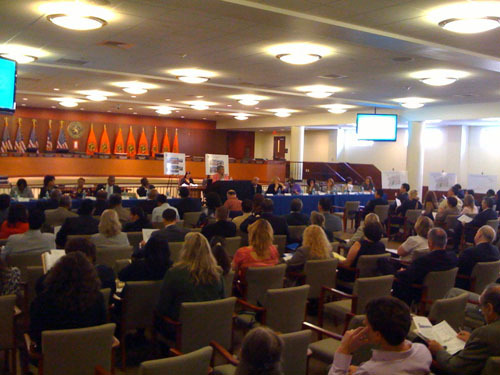Homeowners, lenders meet on Nassau foreclosures
Roundtable examines ongoing issue in Elmont and rest of county
Nassau County financial and real estate experts tackled the problem of foreclosures at a roundtable discussion last week. The event, held Friday at the Nassau County Executive Building, was designed as both a problem-solving session and a question-and-answer forum for residents, and was part of an effort by the county executive’s office to keep people in their homes.
Foreclosures and distressed mortgages have been a huge issue in Nassau County for years, with homeowners falling victim every day. “Foreclosures in New York are the highest in the nation,” said County Executive Ed Mangano, whose office spearheaded the event. “Our goal here in Nassau County is to keep people in their homes. We have aggressive programs to help people find housing, but there’s no better way to avoid emergency housing than to try to keep people in their present homes.”
The county’s efforts have helped in some areas, but the problem is too large for just one solution, many experts testified. A large map at the front of the Nassau County Executive Building’s conference room showed areas of rising foreclosures. Elmont, Valley Stream, Hempstead and Baldwin, among others, showed an average of 33 to 66 distressed loans for every 1,000 units of housing. The county considers a mortgage to be in distress if it is 90 days delinquent or already in foreclosure.
The experts included representatives of lenders such as Bank of America and Wells Fargo, Assistant Attorney General Valerie Singleton and Michelle Di Benedetto, director of public outreach for the Long Island Housing Partnership.
The panel said that the best possible way to help residents in areas with higher concentrations of distressed mortgages was a multi-pronged approach. “You have to be collaborative — there’s not one fix for all,” said Marie Day, a representative of Wells Fargo. “It really takes all of us working together to help our customers and these homeowners.”
Many agreed that mortgage education — teaching potential buyers just what they are signing — is the first step. “There was a study done, maybe a year or so ago, that said that mortgage counseling, when you did it from the first-time buyer’s point of view, less than 1 percent of people went into foreclosure that went into mortgage counseling,” said Di Benedetto. “One of the toughest issues surrounding that is just getting the word out.”
In addition to education, the experts said, getting lenders and homeowners to the negotiating table for refinancing was another huge part of stopping the rising tide of foreclosures. “One of the things that we have found is that early action by the customer is really one of the most effective ways to keep them in their home,” said Day. “When [homeowners] contact us early to let us know that they’re in distress, we have more options available to them to retain the home.”
In addition to counseling communication with lenders, county officials pointed residents to the Nassau County Homelessness Prevention and Rapid Rehousing Program, which is designed to help those who are on the verge of losing their homes to foreclosure. The program starts with prevention services, which include case management and financial assistance, for as long as 18 months in some cases.
Case managers and housing counselors keep track of Nassau County residents in the program, who apply through the Homeless Services Helpline. There is a maximum income for those who apply, ranging from $36,300 for a household of one up to $68,400 for a household of eight.
Finally, enforcement of laws against taking advantage of those in distress is a big deal in areas — like Elmont — where companies claiming quick foreclosure bailouts proliferate. “As the state’s chief law enforcement officer, Attorney General Andrew Cuomo has launched wide-ranging investigations into the so-called foreclosure rescue industry,” Singleton said. “Our investigation is in response to hundreds of complaints that we’ve received from around the country and Long Island.”
Last month, Cuomo launched several suits against companies in Elmont because the community has been targeted by companies that engage in foreclosure-rescue scams.
Mangano concluded that the responsibility to help homeowners in Nassau County fell to the government, because the problem had grown too big for there to be one easy answer. “It’s government’s responsibility to help people find housing, because I think that government is somewhat responsible for what has occurred,” he said. “It’s a result of very poor policies with respect to lending. The practical effect of this is that the housing market was artificially heightened.”
The most important thing to remember, Mangano added, was that for homeowners who reach out for assistance, there is light at the end of a very dark tunnel. “We can always dwell on the past,” he said. “We should learn from it, never repeat it, and help those in need.”
Comments about this story? MHampton@
liherald.com or (516) 569-4000 ext. 214.

 59.0°,
Partly Cloudy
59.0°,
Partly Cloudy 




